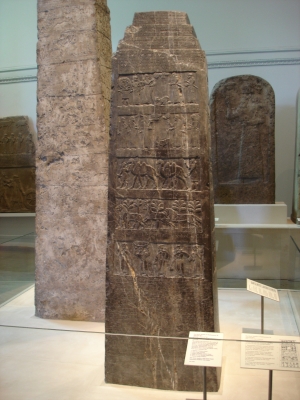Black Obelisk

Black Obelisk of Shalmaneser III in the British Museum, the White Obelisk of Ashurnasirpal I just behind
|
|
| Material | black limestone |
|---|---|
| Size | c.1.98 metres high, 45 cm Wide |
| Writing | Assyrian |
| Created | 858-824 BC |
| Discovered | Nimrud, Iraq |
| Present location | British Museum, London |
| Registration | ME 118885 |
The Black Obelisk of Shalmaneser III is a black limestone Assyrian sculpture with many scenes in bas-relief and inscriptions. It comes from Nimrud (ancient Kalhu), in northern Iraq, and commemorates the deeds of King Shalmaneser III (reigned 858-824 BC). It is on display at the British Museum in London, and several other museums have cast replicas.
It is the most complete Assyrian obelisk yet discovered, and is historically significant because it is thought to display the earliest ancient depiction of a biblical figure - Jehu, King of Israel. The traditional identification of "Yaw" as Jehu has been questioned by some scholars, who proposed that the inscription refers to another king, Jehoram of Israel. Its reference to 'Parsua' is also the first known reference to the Persians.
Tribute offerings are shown being brought from identifiable regions and peoples. It was erected as a public monument in 825 BC at a time of civil war, in the central square of Nimrud, close to the much earlier White Obelisk of Ashurnasirpal I. It was discovered by archaeologist Sir Austen Henry Layard in 1846 and is now in the British Museum.
It features twenty relief scenes, five on each side. They depict five different subdued kings, bringing tribute and prostrating before the Assyrian king. From top to bottom they are: (1) Sua of Gilzanu (in north-west Iran), (2) "Jehu of Bit Omri" (Jehu of the House of Omri), (3) an unnamed ruler of Musri (probably Egypt), (4) Marduk-apil-usur of Suhi (middle Euphrates, Syria and Iraq), and (5) Qalparunda of Patin (Antakya region of Turkey). Each scene occupies four panels around the monument and is described by a cuneiform script above them.
...
Wikipedia
